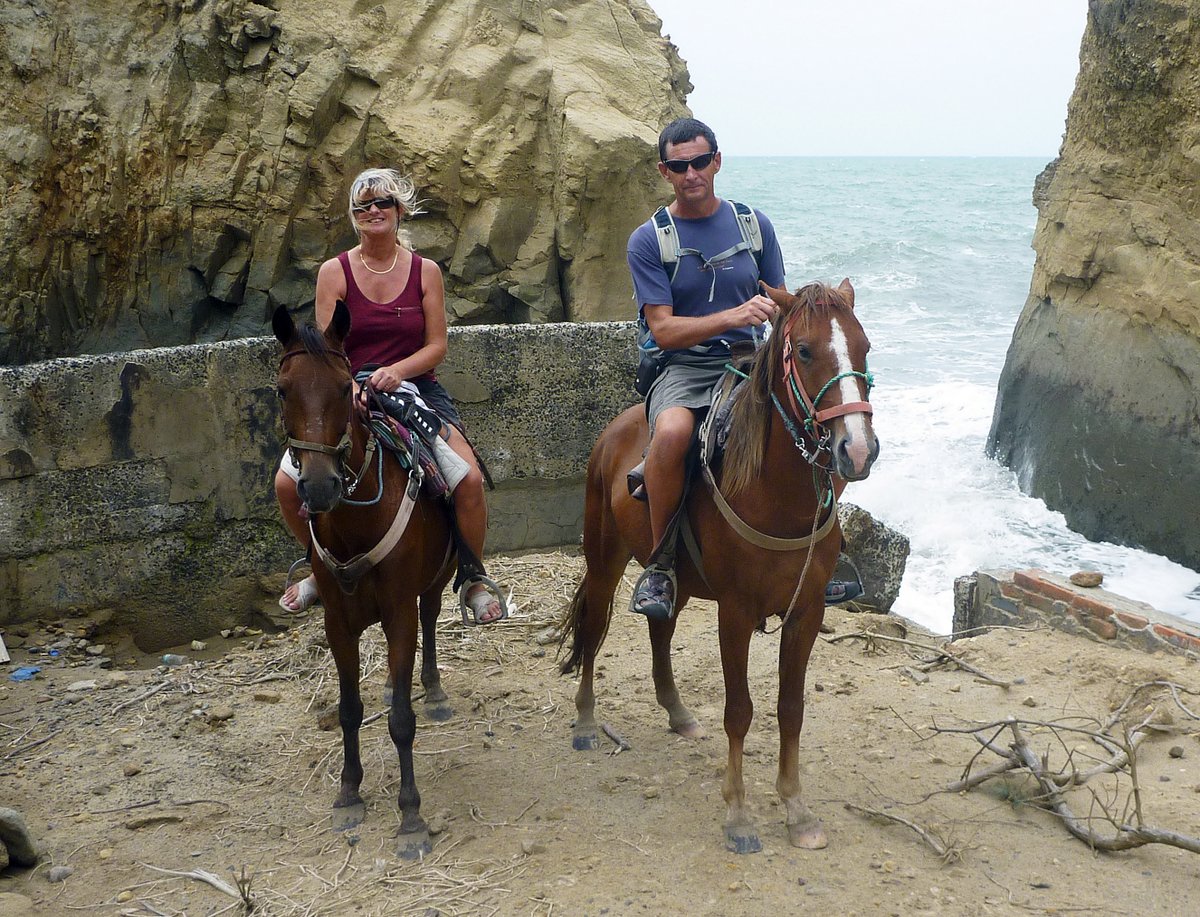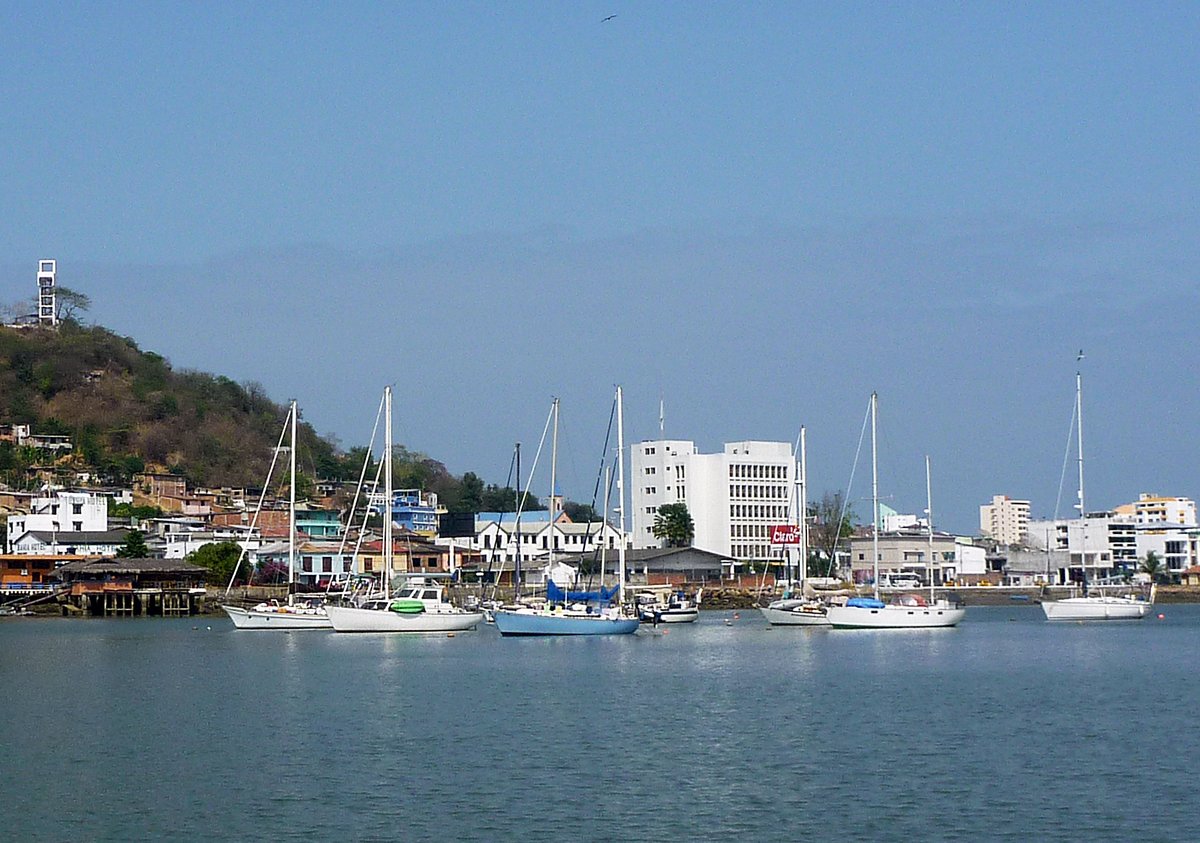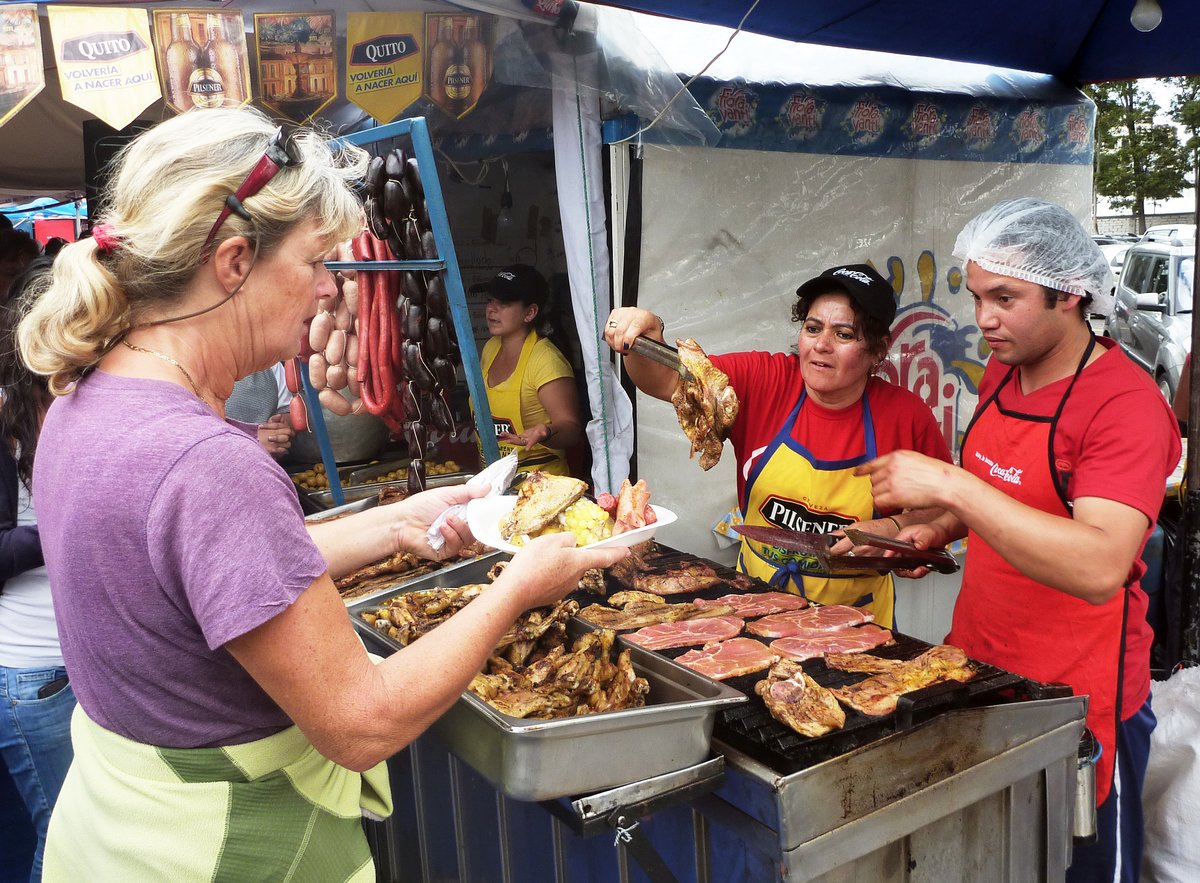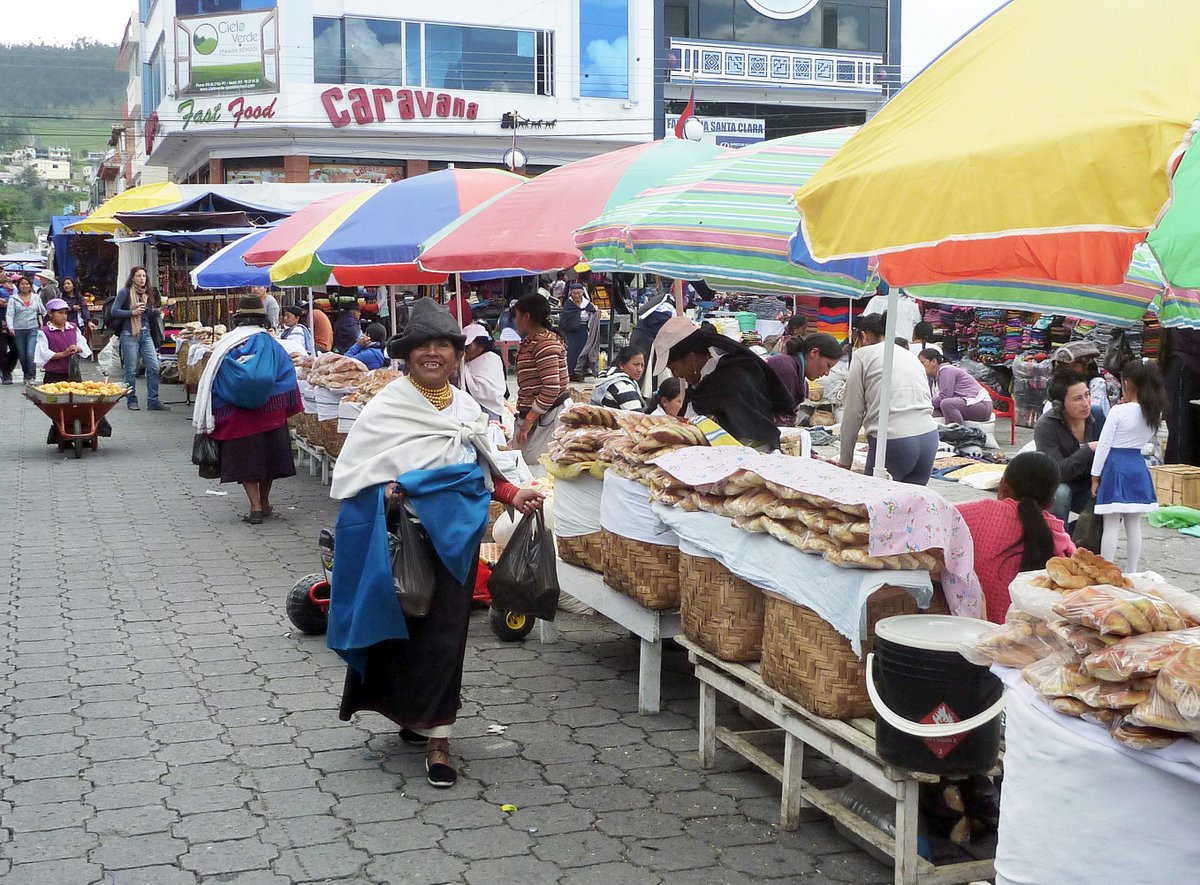1 December 2013 Bahia de Caraques, Ecuador
We caught the bus to Canoa, a small sea side town about ten minutes along the coast. The buses go every half an hour and it’s only $1 each for the 30 minute journey. Canoa is a surfing place, so there are loads of surfers and hippies wandering around everywhere selling their silver and macramé jewellery. For some reason, there seems to be an abundance of small pipes and small pouches on sale...
We called in at a hostel called Coco Loco and found out that they can arrange horse riding with just an hour or so notice. A two hour ride costs £25 each and they’ll take us along the beach or inland around the fincas. Unfortunately, they couldn't arrange anything today because everyone (including the caballeros) has a hangover after a big parade and party last night!
We walked onto beach and came across a few old guys with four horses. They only charge $10 per hour, so Glenys couldn't resist. We went with a guide for a two hour ride in sandals and shorts. The horses were very responsive, but the tack was very basic – my saddle was made from carved wood with a tiny blanket to soften it up a bit. I felt a bit precarious perched on top of it and, after half an hour, I’d managed to rub the skin off one of my ankles – not pleasant.
We had a good canter along the beach and then went inland past shrimp farms and up into the hills, ending up on some impressive looking cliffs with a great view back to town. It was a fun ride, trotting and cantering whenever we wanted. The guide didn't mind us taking off ahead of him, which was a good job because my horse was loco.
Back in town, we went into one of the many restaurants for lunch. They brought out a full menu offering a variety of meals including cerviche and fried fish – all between $5 and $10. The secret in these places is to ask for Almuerzo, which is a set lunch normally consisting of soup followed by a plate of rice and beans with some meat or fish. We opted for Almuerzo and had a really nice tasting fish soup followed by fried fish with rice and beans. They also served us with some fruit juice that I think was fresh mango - a bargain for $3 each.
In the evening, we were invited over to “Sundancer” by Ron and Heather for a beer or five.
2 December 2013 Bahia de Caraques, Ecuador
We had an internet day today. Glenys was on a mission to organise an inland trip to Quito and the Valley of the Volcanoes, with horse riding and hiking. We’re planning to go later this week because there’s a festival running in Quito at the moment, which finishes on Friday, so it would be good to see that.
I wandered into town to send off some paperwork to a couple of banks in the UK – it cost me a massive $82 to send the four letters, but I can’t trust the post here or in the UK around Christmas. I also arranged to pick up a mooring tomorrow morning, so that Alba will be safe while we go on our road trip.
The mosquitos are a damn nuisance around here - we killed ten in our bedroom the other night. They’re fast little buggers – we’ve resorted to having mosquito netting up on all the windows and in the cockpit all the time. We’re also running small tablet heaters all day and night. We finally seem to have them under control now, but there always seems to be one lurking somewhere.
3 December 2013 Bahia de Caraques, Ecuador
We picked up our mooring in the morning. Each boat has a bow and stern mooring and we’re all lined up very close to each other, so it’s a bit of a shock when I look outside and see a boat only 5 metres away.
Glenys spent the rest of the day doing more planning on the Internet. She booked a hotel in Quito for five days and then went to the bus station to book tickets to get us there – it only cost $10 each for the 8 hour journey. I chilled out, playing the guitar and messing about on the internet.
We had David and Gita from “Aros Mear” over for cocktails and they’ve kindly said that they’ll drop us ashore when we go to Quito, so that we can leave our dinghy securely pulled up on our davits.
4 December 2013 Bahia de Caraques, Ecuador
Glenys continued acting as a travel agent and booked us into two hostels that are in the area of the Quilotoa Volcano. The idea is that we’ll hike for five hours from one hostel to the other. However, we don’t want to be carrying our heavy luggage with us, so the hostel can transfer our luggage by road for $30 or alternatively we can hire a guide and a pack horse for the same price. It’s a no brainer – it will be much more interesting to spend the $30 on a pack horse.
We spent the rest of the day packing and getting the boat ready to leave it for two weeks on a mooring.
5 December 2013 Bahia de Caraques to Quito, Ecuador
We were up at half past six and finished of the few small jobs on the boat, switching things off and closing sea cocks. David from “Aros Mear” picked us up and dropped us ashore and then we caught a local bus to the bus station.
The Quito bus left on time, the only hassle was that the woman checking the tickets wouldn’t let us take both of our small rucksacks on board. I admit that they were rather jam packed, but the bus was half empty. Anyway, we had to do a bit of panic repacking leaving our netbook and some other valuable items in my rucksack which went into the luggage hold – a bit worrying.
The trip to Quito is interesting because the landscape changes as one travels from the coast into the high mountains – Quito is at 2,800 metres altitude. At the coast, the vegetation is quite arid with thousands of shrimp farms dotted around - I believe that Ecuador is one of the largest producers of farmed shrimp in the world. As we gained altitude, the landscape became more verdant with crops of bananas and then to Cloud Forest, which looks similar to Rain forest. As we approached Quito the landscape became more dry and mountainous.
The bus stopped several times in the eight hour journey – once for lunch where we had a massive meal for $3 each. The other stops were at various towns, where vendors would be let on board to allow us to indulge in a bit of street food – Pan de Yuca, pastries, fruit, etc. There was no way that we were going to starve.
Quito is in a valley formed by volcanos and the city sprawls along the valley floor with over two million inhabitants. It’s an impressive sight looking down into the valley as the bus comes over the mountain ridge.
The bus dropped us off on a street corner somewhere in the middle of the sprawling city. I was quite relieved to find that our two big rucksacks and my small rucksack were still in the luggage hold. We took a cab for $4 to the Hotel Antinea in the Mariscal area of town (also called the New Town). The hotel is very nice. It’s a small colonial type hotel with 15 or so rooms and costs $70 per night for a double room with continental breakfast. The receptionist speaks very good English and is very helpful.
We unpacked and went out for a walk around the bustling streets. Tomorrow is Quito’s Founders Day which celebrates the creation of the city by the Spanish in 1534. The whole place has been in party mode for past week, so there were bands playing in various squares and loads of people wandering about having a good time. We watched a rock band play a few Oasis numbers and another band that were playing Latin American music with a great brass section. There are loads of restaurants in the area, but we’d eaten so much during that day that we satisfied ourselves with some Nachos and a couple of tacos in a small bar.
6 December 2013 Quito, Ecuador
Our grand plan was to go to a bull fight today, despite the fact that the Ecuadorian government has recently caved into the animal rights people and banned the killing of bulls. A series of bull fights had been arranged over four days with the final day today. Unfortunately, because of lack of attendance and hassle from the anti-bull fighting organisations, the bull fight today was cancelled. It’s a shame because I was looking forward to watching the horse riding and the overall pomp and ceremony. It may be that we’ve missed our last chance to see a real bull fight.
Instead, we went shopping for a pair of hiking boots for Glenys because the soles fell off her old ones in Costa Rica. There are a few outdoor activity shops in Quito, so she’d bought a pair by lunchtime. As we wandered about, I tried to find somewhere to buy some printer cartridges and a camera battery, but a lot of shops were closed because it’s a holiday – just my luck.
We came across a bunch of stalls selling food on a busy crossroads. It was a very festive affair with packed tables and loud music. We bought our lunch from one of the barbecue stalls and it was the most meat that I’ve ever seen on a single plate - four types of sausage, a piece of chicken, three small potatoes, a tough bit of corn cob, a token bit of lettuce and a plate-sized piece of barbecued pork sitting on top of it all.
Stuffed with enough protein to last a week, we caught a cab to the old town and wandered around the streets with thousands of locals enjoying the day. It was pleasant enough, but just another city. In the evening, we joined the crowds lining the Avenue de Amazons to watch a big parade, but it absolutely threw it down, forcing us to escape to an Italian restaurant for a pizza – carbohydrates to offset all the protein that we had for lunch.
7 December 2013 Quito, Ecuador
We had an early start and took a taxi cab to the North Bus station (Terminal Carcelen) to catch a bus to Otavalo Market. The first cab that we got into said that it was going to cost us $10; then quickly dropped to $8 when I argued; and finally dropped to $7 as we climbed out of the cab – robbing bastard. The next taxi driver agreed $5 for the trip. I know taxi fares are low here in Ecuador, but even I was getting embarrassed after we’d been driving for 30 minutes and still hadn’t arrived. The bus to Otavalo was even cheaper at $2 each for the two hour journey.
The Otavalo market is huge and is a mixture of items for locals and stuff for tourists like Llama hats, Llama blankets, Llama dolls, Llama hoodies, Llama jewellery, etc, etc. I wasn’t too impressed because I was hoping for a more “local” market with some animals, but Glenys had a good time and bought some earrings and a cowboy hat ready to go riding tomorrow. The only thing that I bought was a lovely little gourd which has been intricately etched and painted with (errrr) Llamas and other stuff.
I found out later that the animal market is a couple of miles away, although we did see a guy driving a small gaggle of geese through the market. It was interesting to see the way that the geese threaded their way through the crowds without scattering. They even had some small goslings among them.
The highlight for me was watching the local people. This was the first time that we’d seen the indigenous locals. They wear a variety of clothing – ponchos and felt hats are in abundance, while some of the ladies were stepping out with lovely white embroidered blouses. The most striking thing is that the older locals are so tiny – between 4 and 5 feet tall, and they look so weather beaten and ancient. They also carry heavy loads on their backs which are slung in a blanket. I watched one old lady, who was only 4’6” tall, haggle to buy a huge, 3 foot diameter, 2 foot deep pan and then promptly sling it on her back and stagger off.
Back in Quito, we went to a local bar and tried a Micheada, which is the trendy drink around here. It’s made from beer mixed with lime juice, Worcester sauce, hot chilli sauce and served in a glass rimmed with salt – pretty horrible and a total waste of beer.
- Prev
- Next >>





